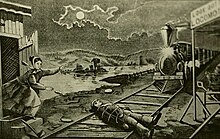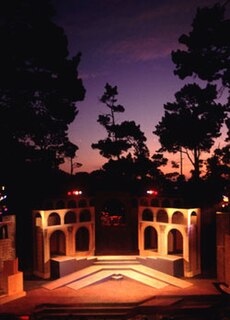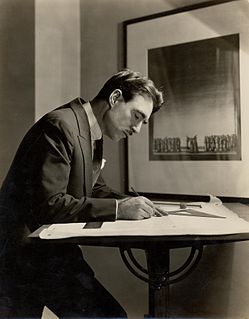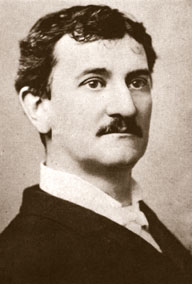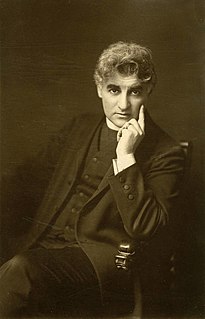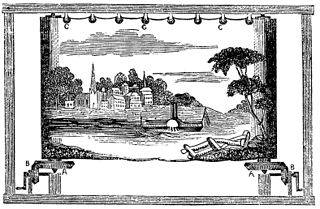Technological advancement
During the nineteenth century, the technology of the Industrial Revolution was applied to theater. Many historians believe that the popularity of melodrama, with its emphasis on stage spectacle and special effects, accelerated these technological innovations: For example, Dion Boucicault was responsible for the introduction of fireproofing in the theater when one of his melodramatic plays called for an onstage fire. [9]
Panorama
While the invention of the panorama is attributed to Robert Barker in 1787, Louis Jacques Daguerre is largely seen as having perfected the invention in the 19th century. He created the diorama: a still painting viewed by an audience sitting on a rotating platform. This soon gave way to the moving panorama: a setting painted on a long cloth, which could be unrolled across the stage by turning spools, created an illusion of movement and changing locales. A popular American play, William Dunlap's A Trip to Niagara (1828), used this device to show a voyage from New York City to Niagara Falls via a steamboat. [10] The advent of the panoramas coupled with Charles Kean’s invention of the Corsican trap meant that entire horse and chariot races could be enacted on stage. [11] The emphasis on recreating natural environments onstage was probably influenced by romanticism, which called for a "return to nature."

Elevator stage
On February 7, 1880, the Spirit of the Times announced: "Tonight Mr. J. Steele MacKaye will open the most exquisite theatre in the world, and all New York will assemble to do honor to the realization of his artistic visions…Mr. MacKaye will play the drama Hazel Kirke through with only two-minute waits between the acts, and will then exhibit the double stage—one compartment set for the kitchen of Blackburn Mill and other as boudoir at Fairy Grove Villa." MacKaye’s elevator stage was an important development of American drama and theatre. It was a solution to the problem posed by the increasing use of box sets to reproduce interior scenes in detail. With the elevator stage, multiple scenes could be changed in a fast and detailed way. This greatly improved the speed and efficiency of scenic changes, and design didn’t have to be simplified; it could still be detailed. The elevator stage was described in Scientific American , April 5, 1884. "[It consists] of two theatrical stages, one above another, to be moved up and down as an elevator car is operated in a high building, and so that either one of them can easily and quickly be at any time brought to the proper level for acting thereon in front of the auditorium. While the play is proceeding before the audience, the assistants arrange another scene on the upper stage." [12]
Edwin Booth Theatre
New styles of scenery meant that new means of scene shifting were needed. Booth's Theatre, opened in 1869, was the first in a new generation of theaters built specifically to suit three-dimensional set pieces. It was the first theater to have a level stage floor (rather than a raked floor, as had been the standard in proscenium-arch theaters since the Renaissance) and no grooves in the stage floor for shifting flats. This idea would become the standard by the end of the century. Elevators and equipment for flying scenery also complemented the space. [13]
Stage lighting
Nineteenth-century technology revolutionized stage lighting, which until then had been primitive. The introduction of gas lighting was the first step. In 1816, Philadelphia's Chestnut Street Theater became the earliest gas-lit playhouse in the world. [14] The introduction of gas lighting revolutionized stage lighting. It provided a somewhat more natural and adequate light for the play and the scenic space upstage of the proscenium arch. However, this new richness in lighting provided difficulties at first. Though scenic painters had to learn to subdue their colors to the increased candle-power, the brightness only further highlighted the disparity between three-dimensional set pieces and their two-dimensional backdrop and led to the latter's eventual decline. The advent of limelight, also known as Drummond light, also effectively introduced spotlighting to theater. [15] Thomas Edison's electric incandescent lamp, invented in 1879, was the next step. It made electricity the most flexible, most controllable, and safest form of lighting; in the twentieth century, it would make stage lighting design a true art. These new means of illumination tremendously increased the control over stage light and stimulated interest in imitating lighting phenomena of nature. [16]

